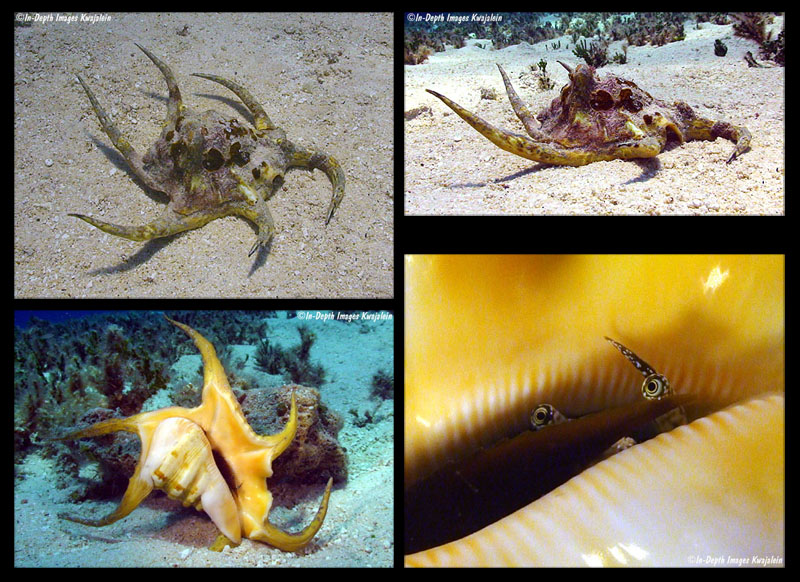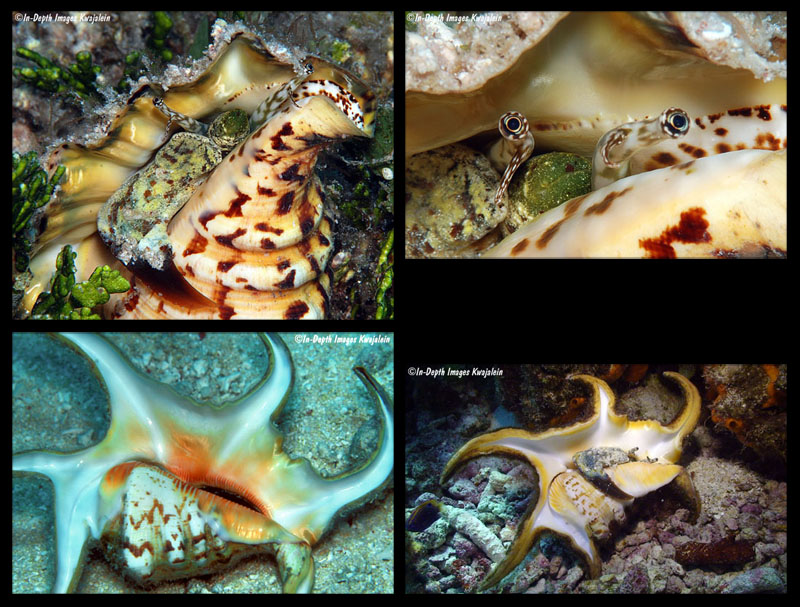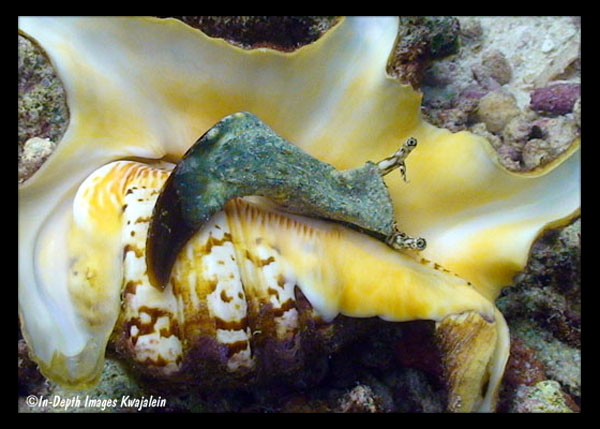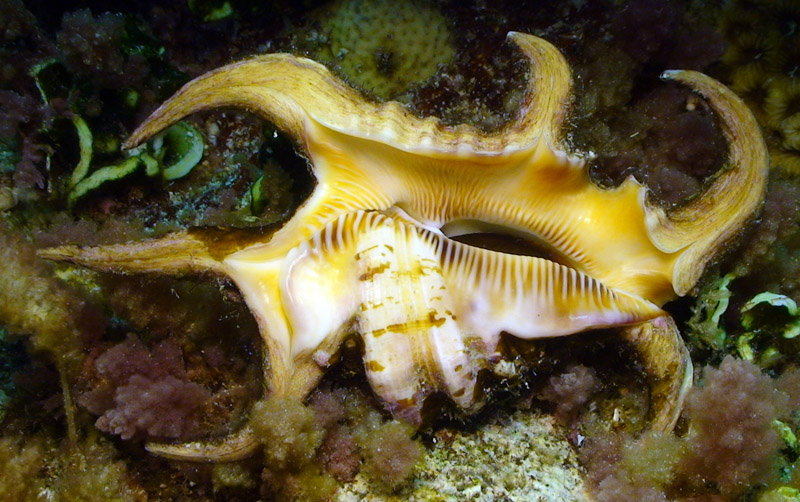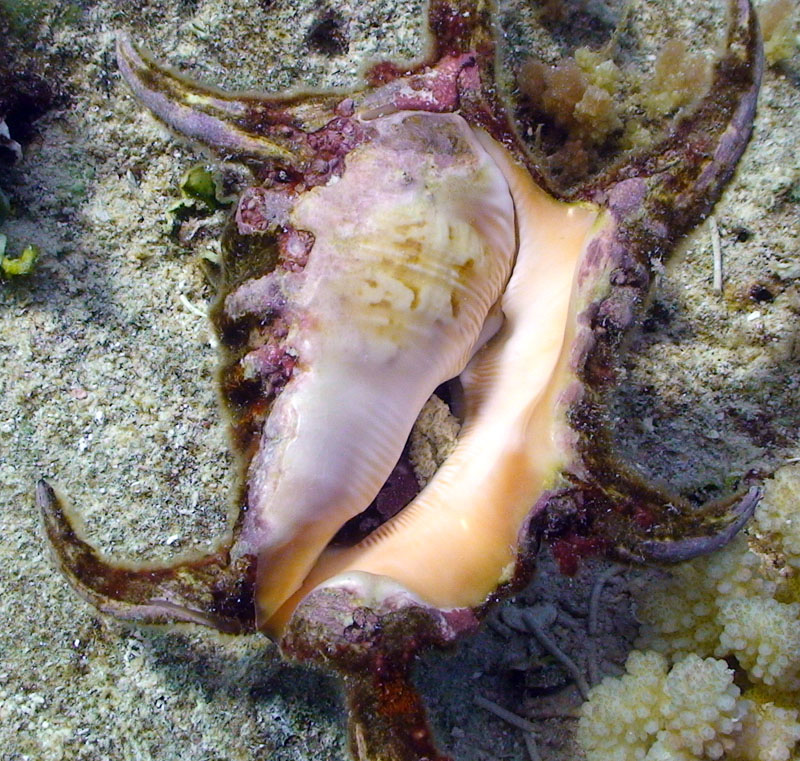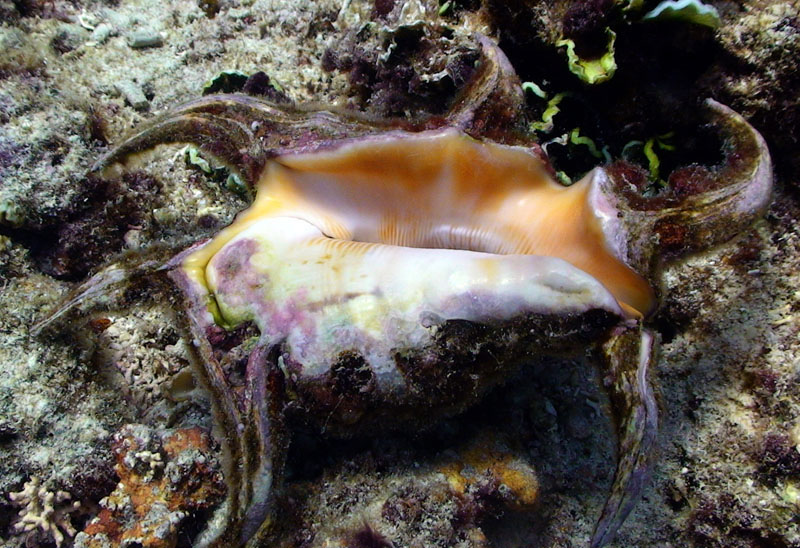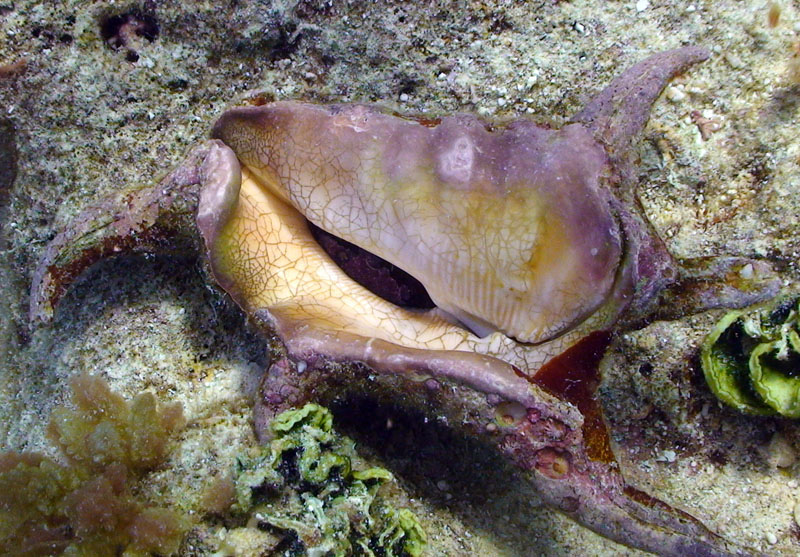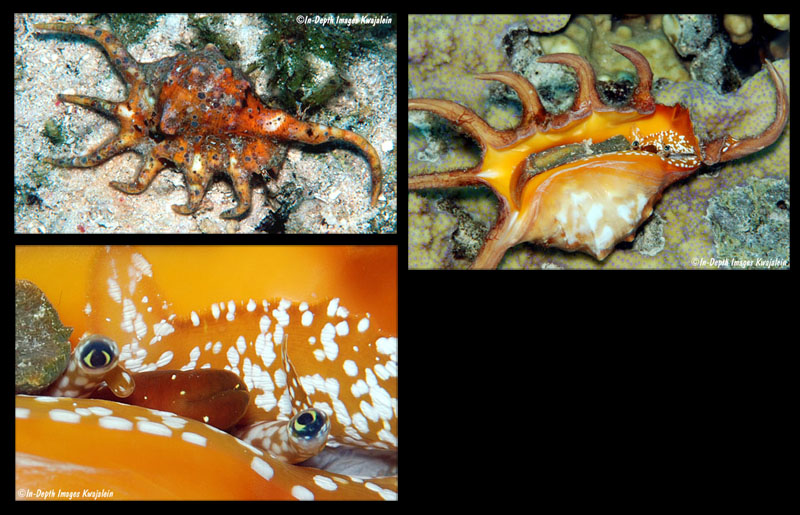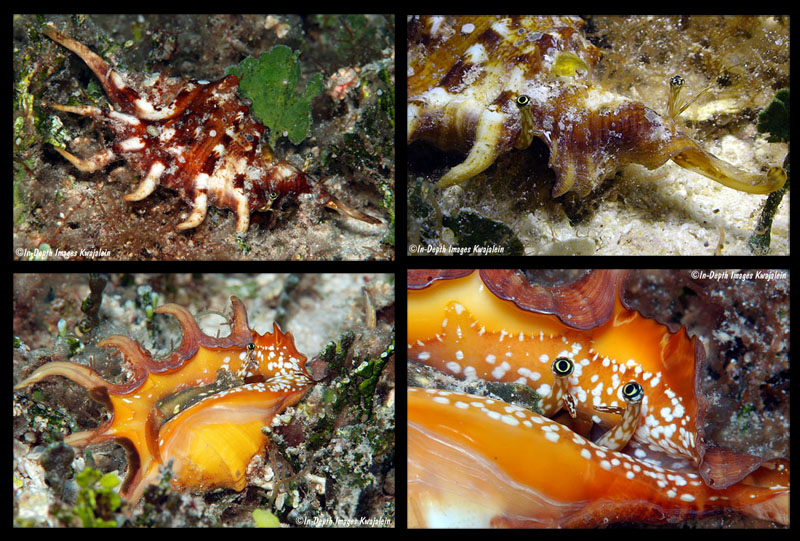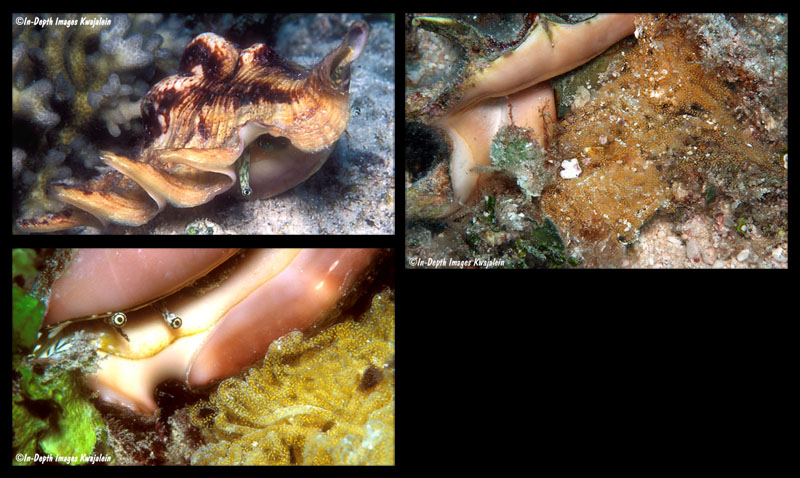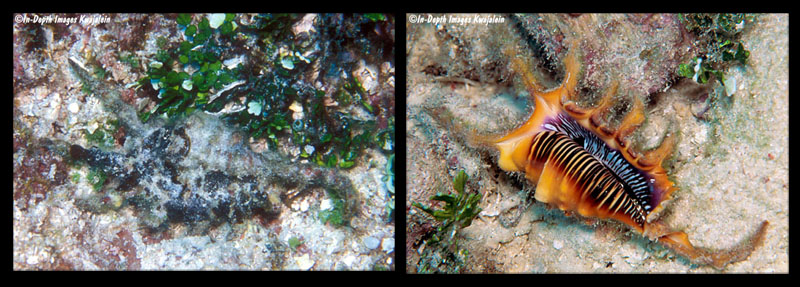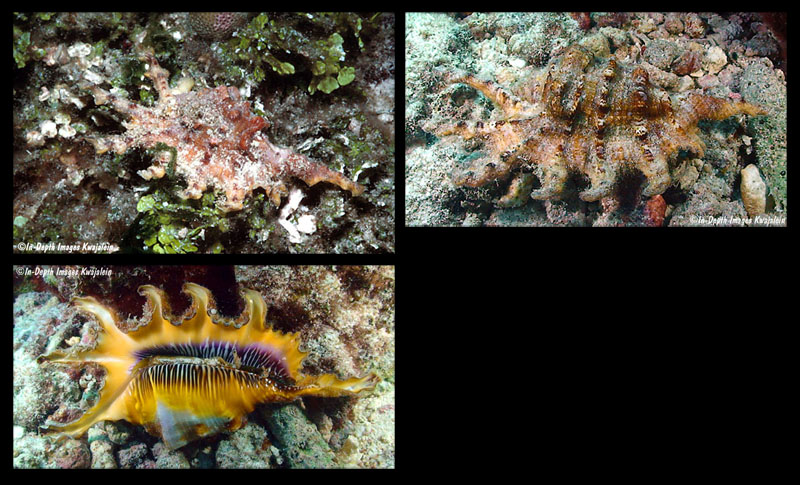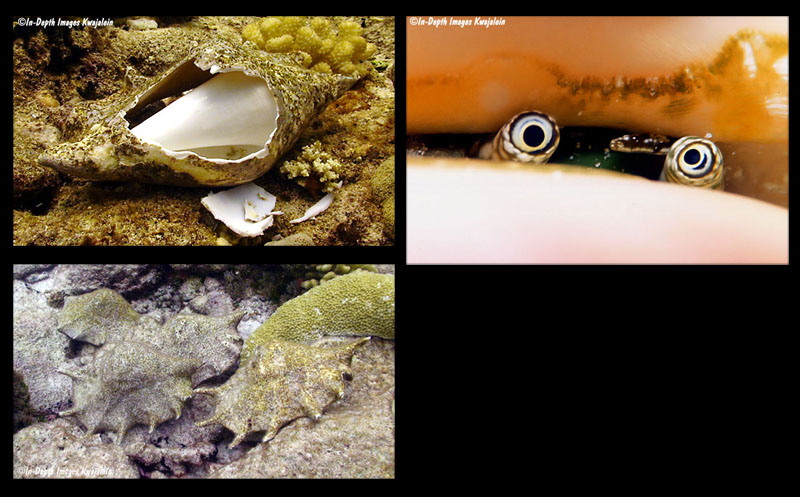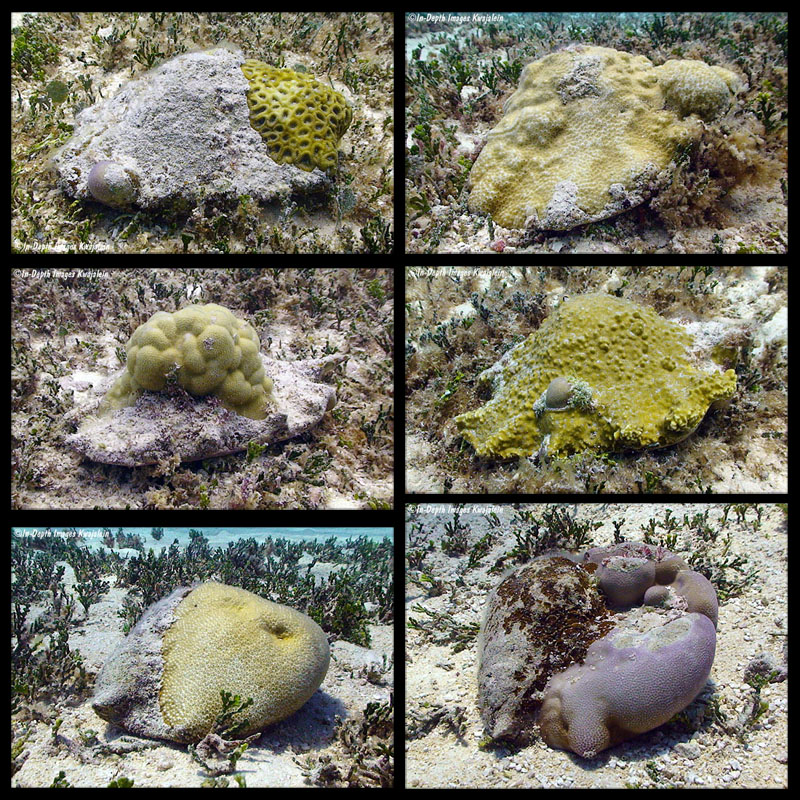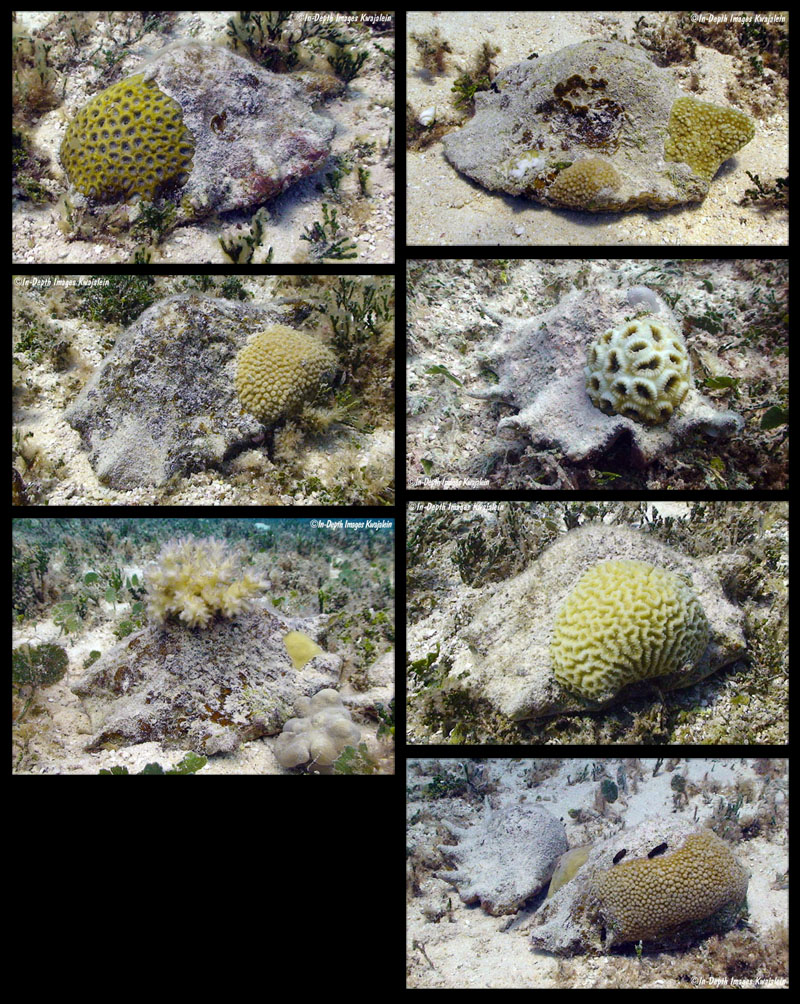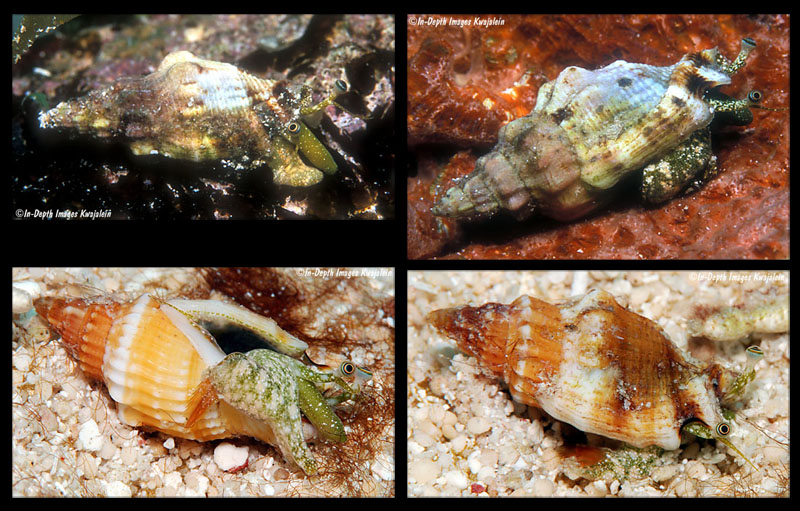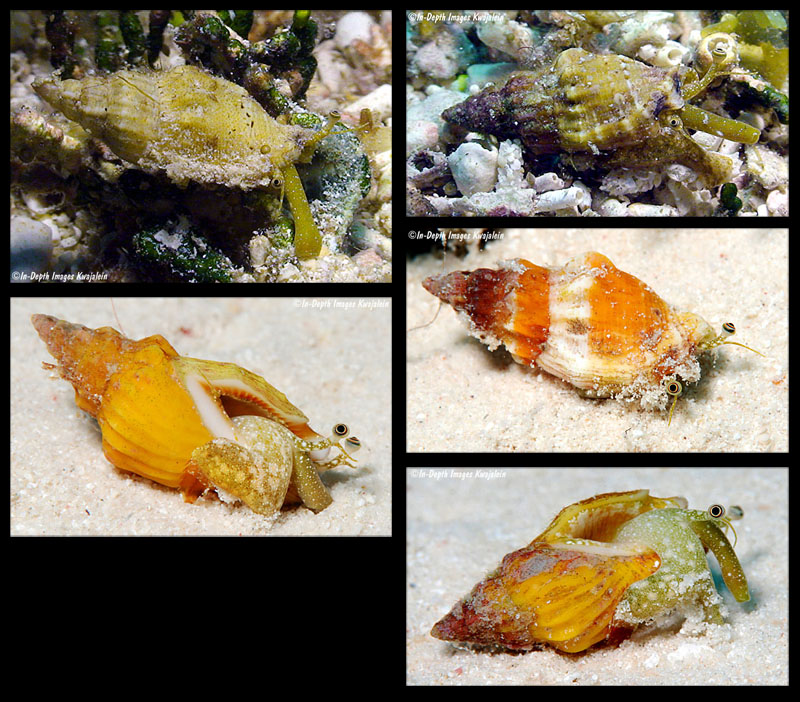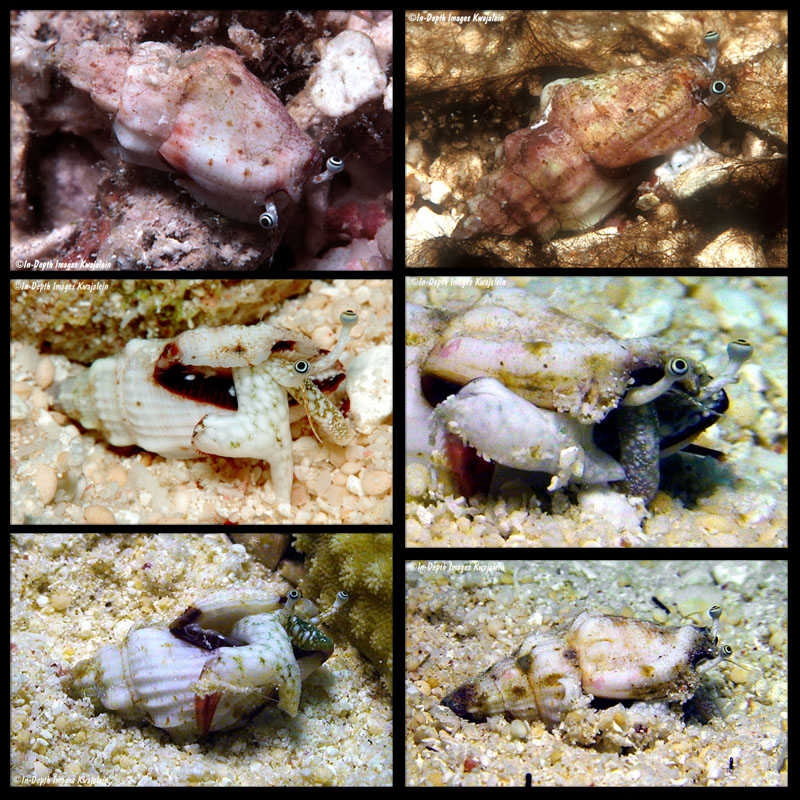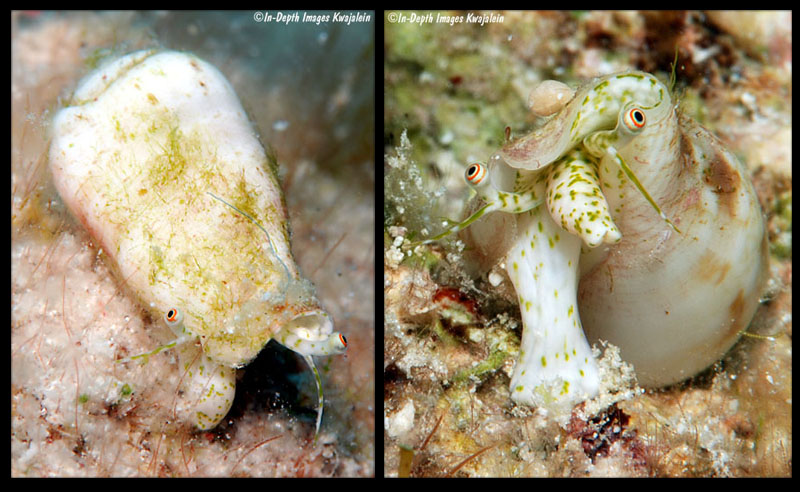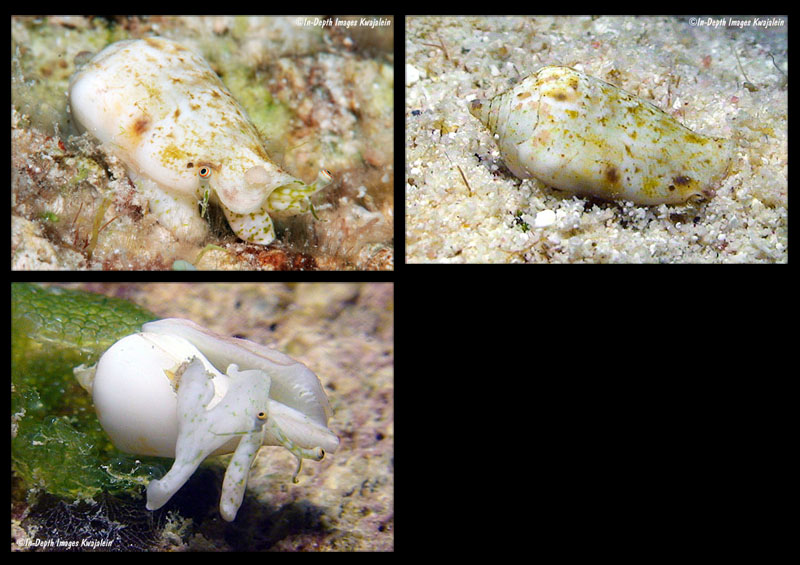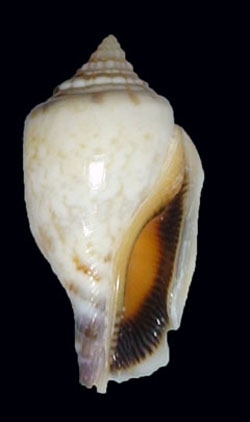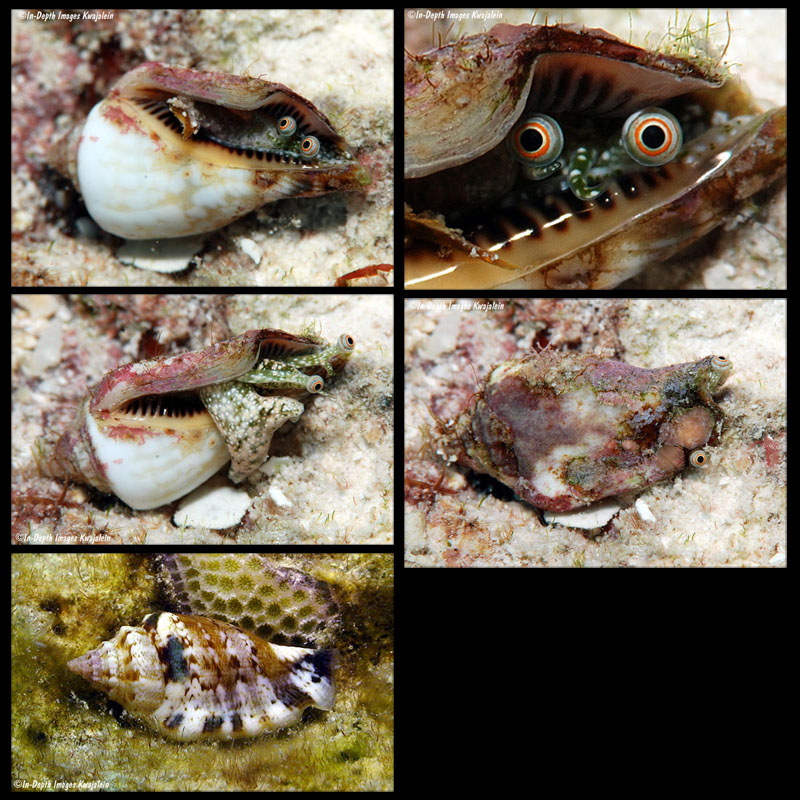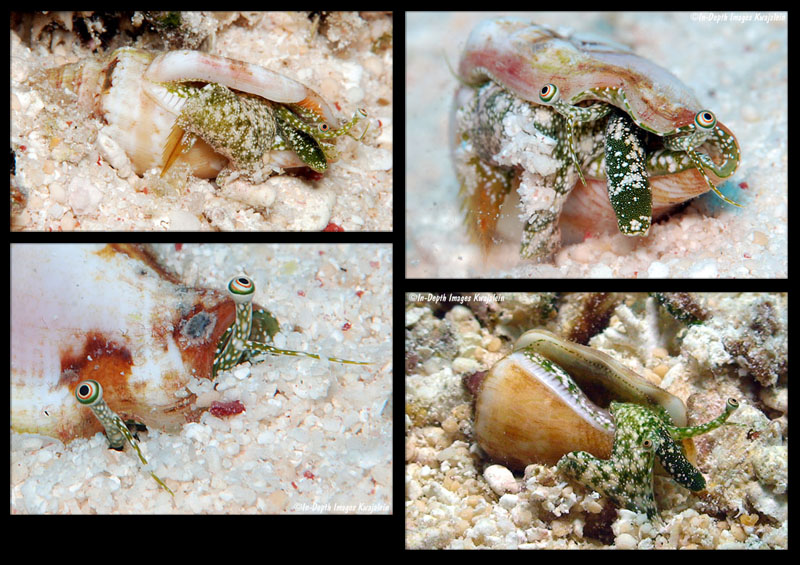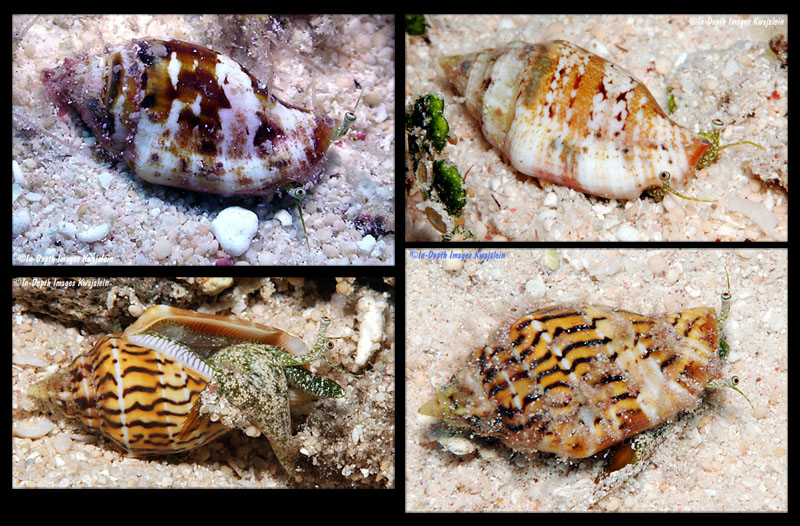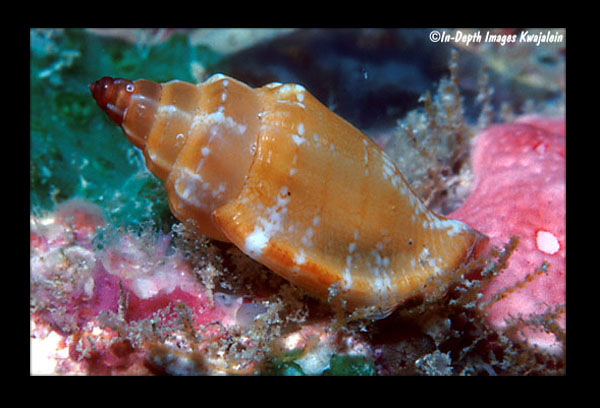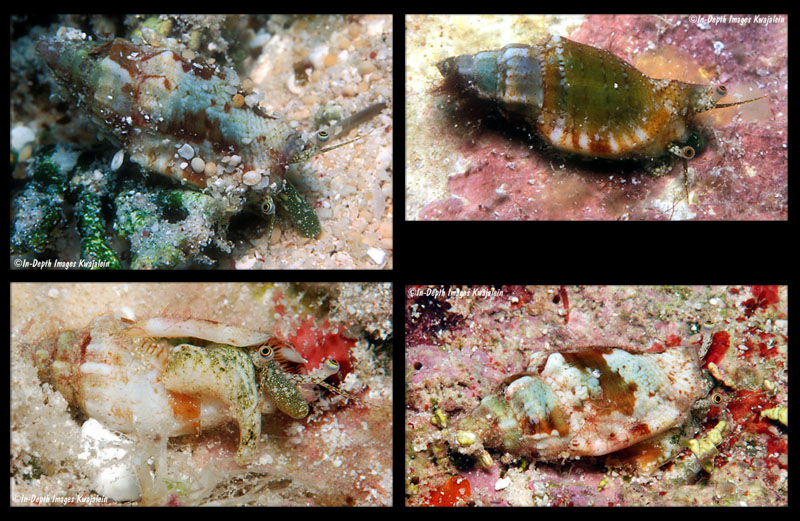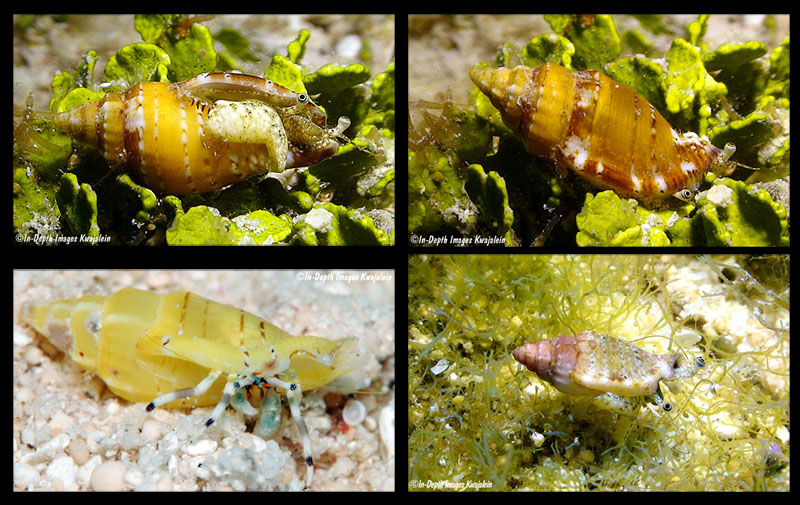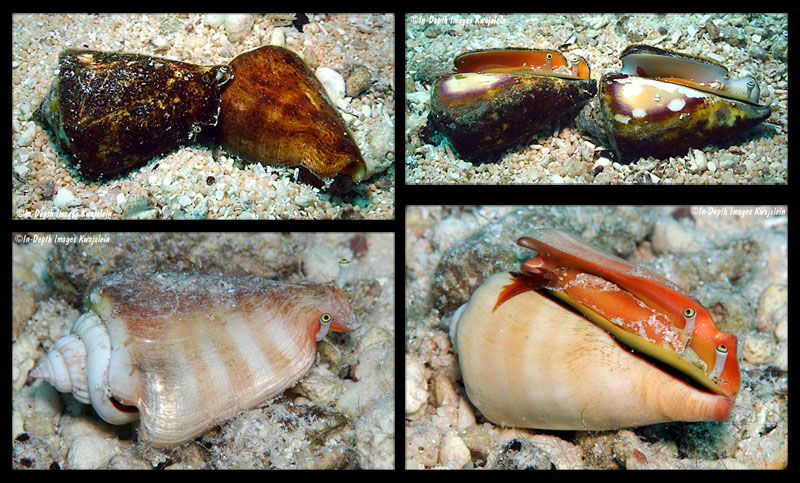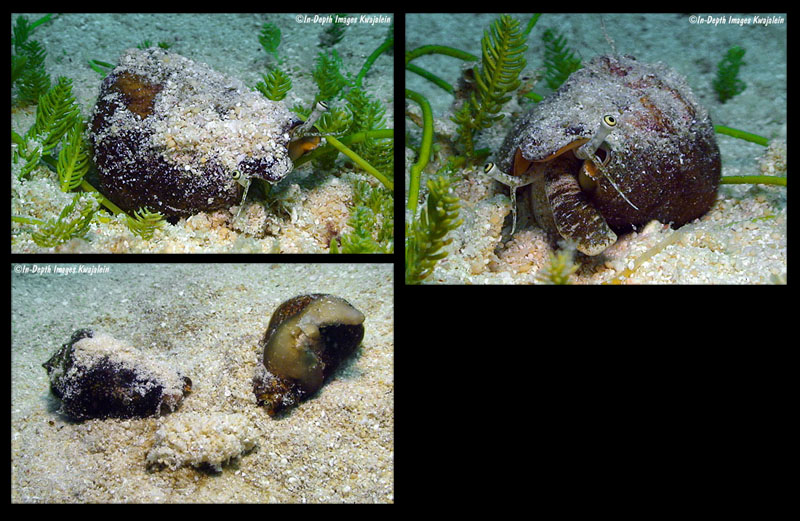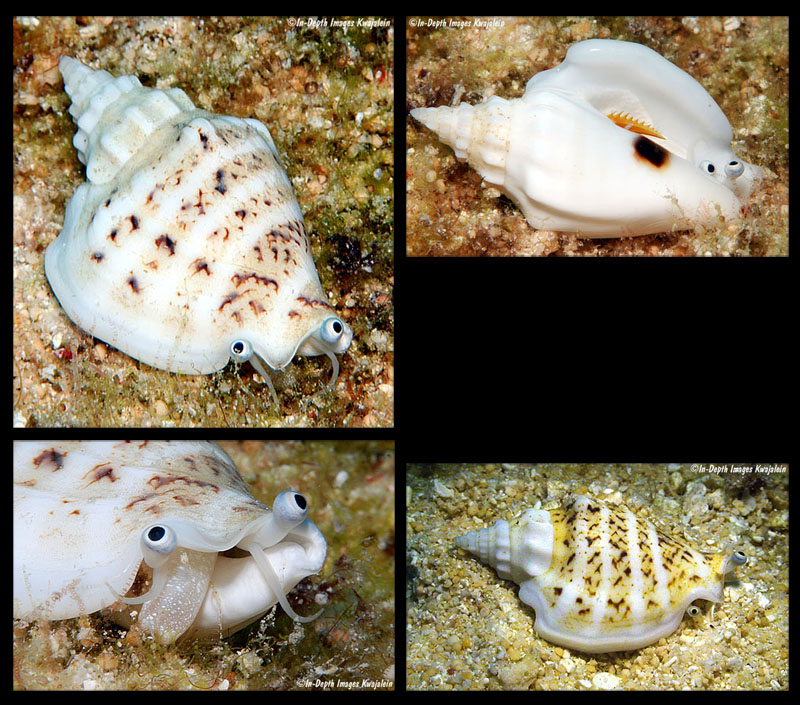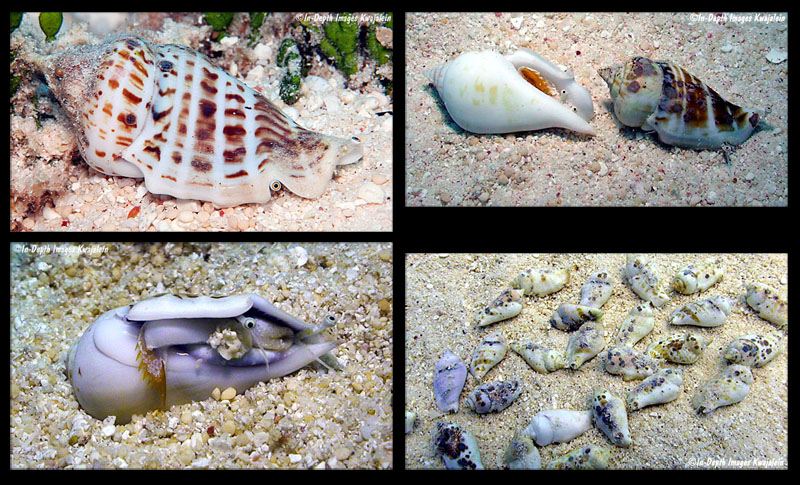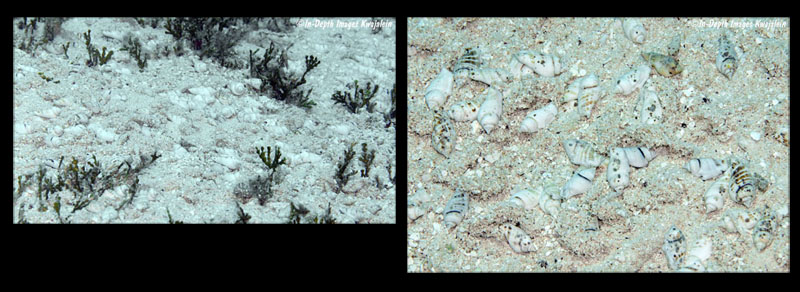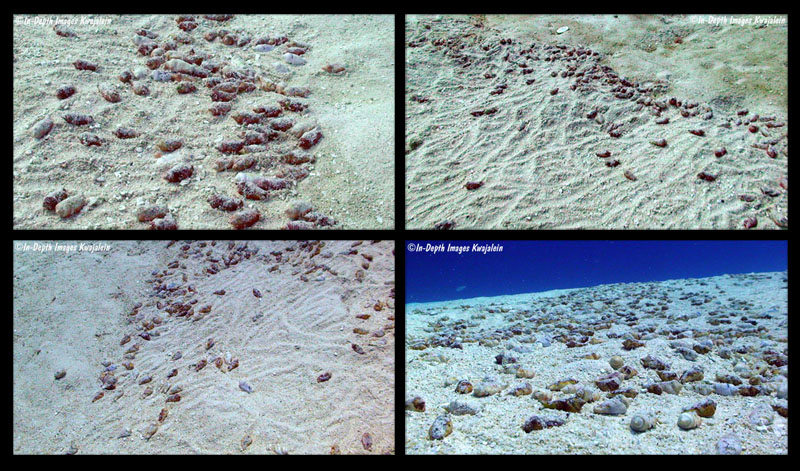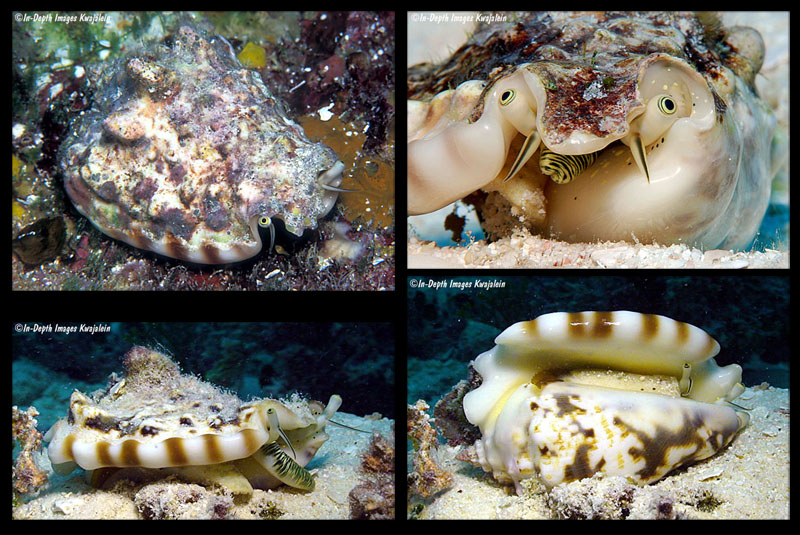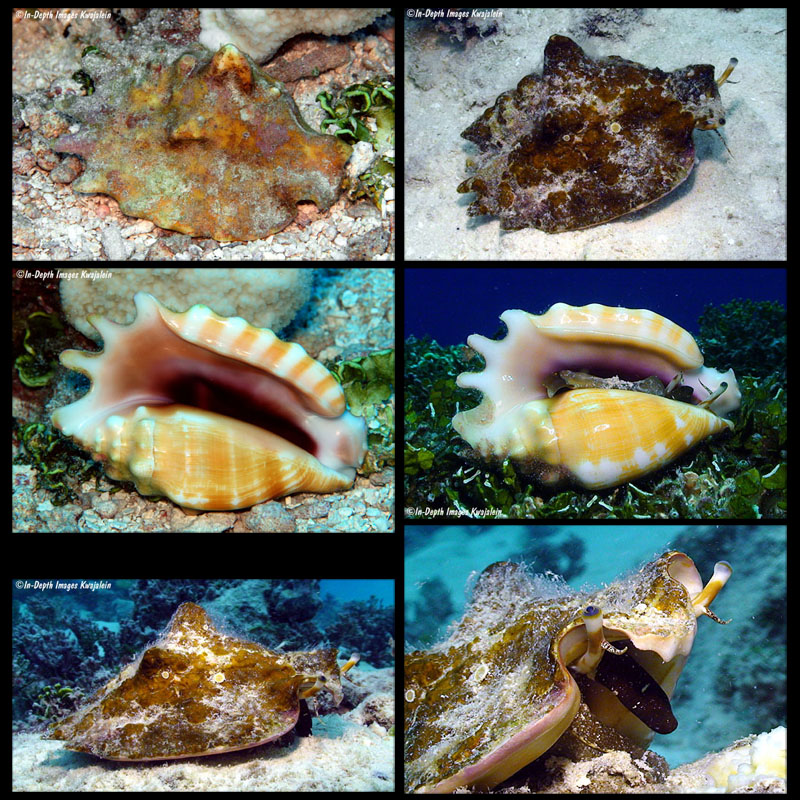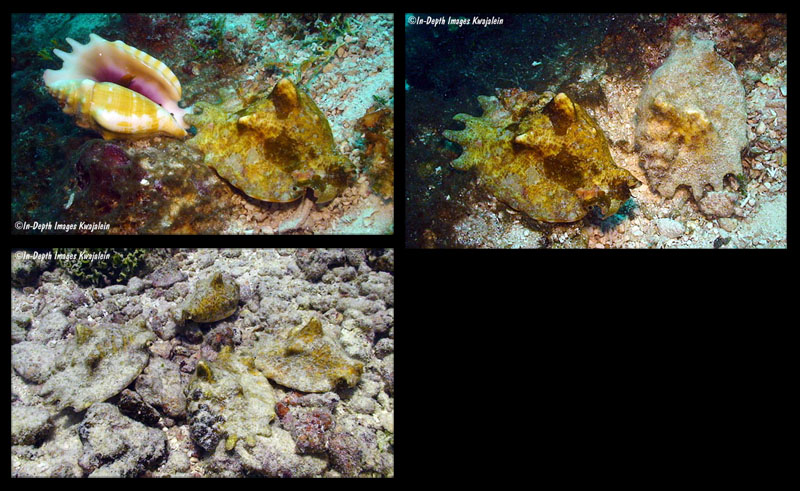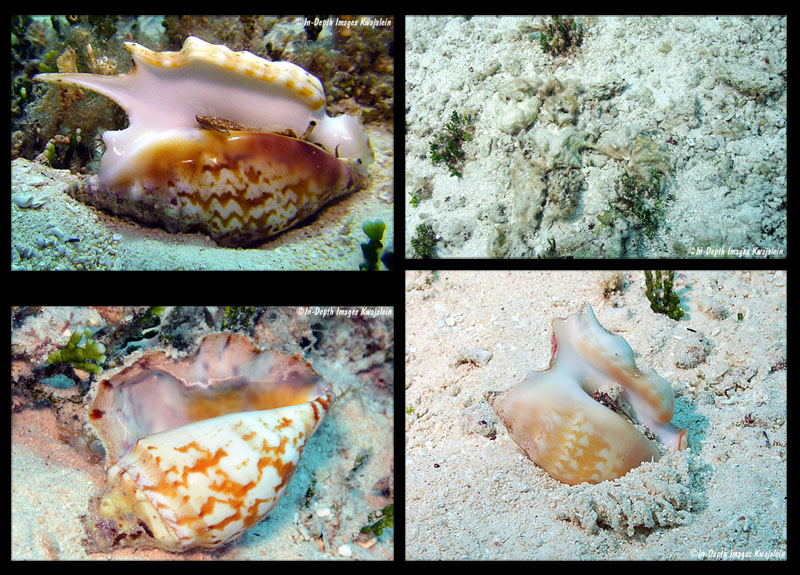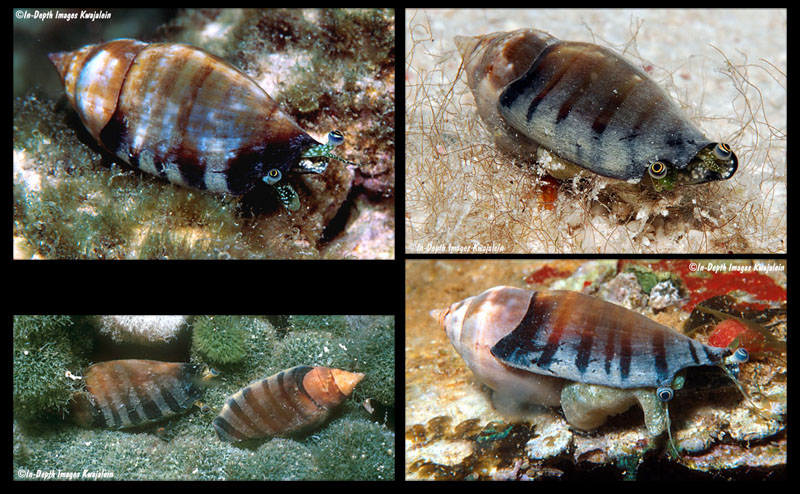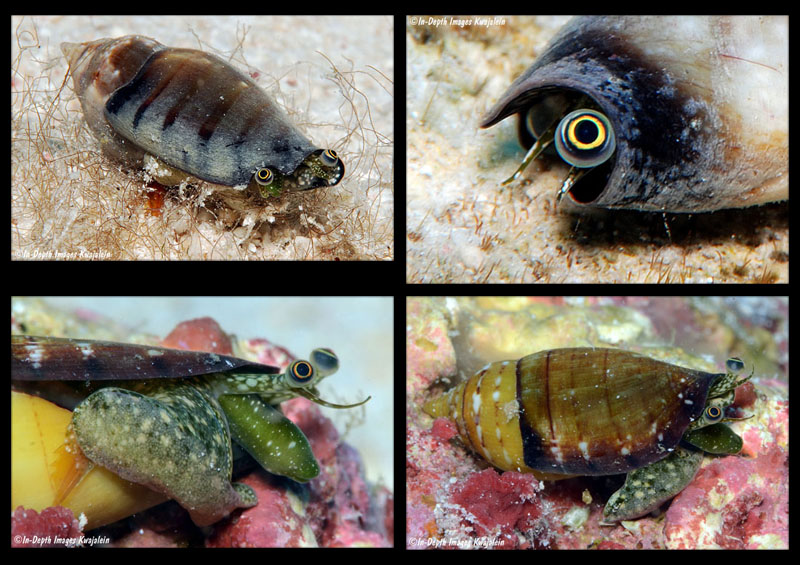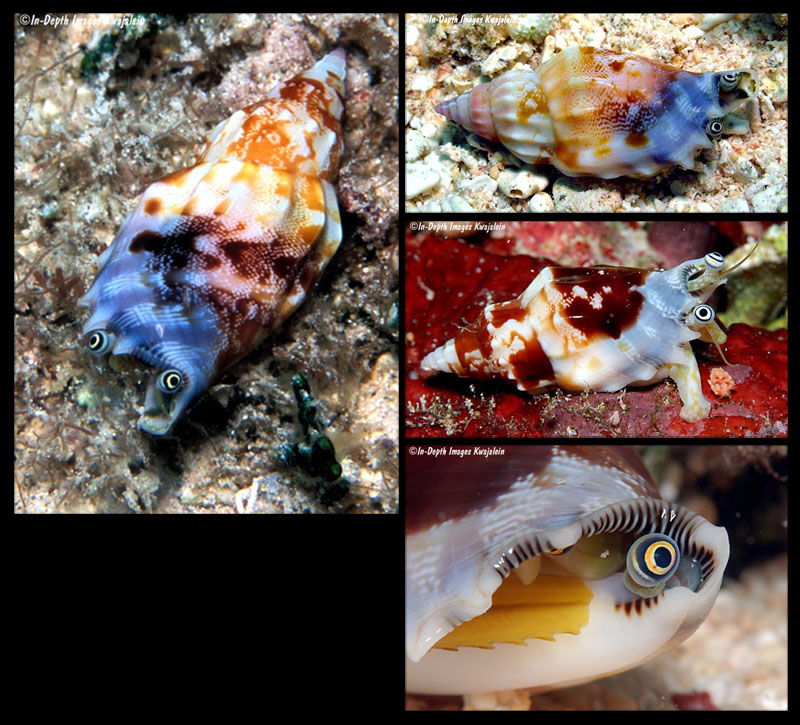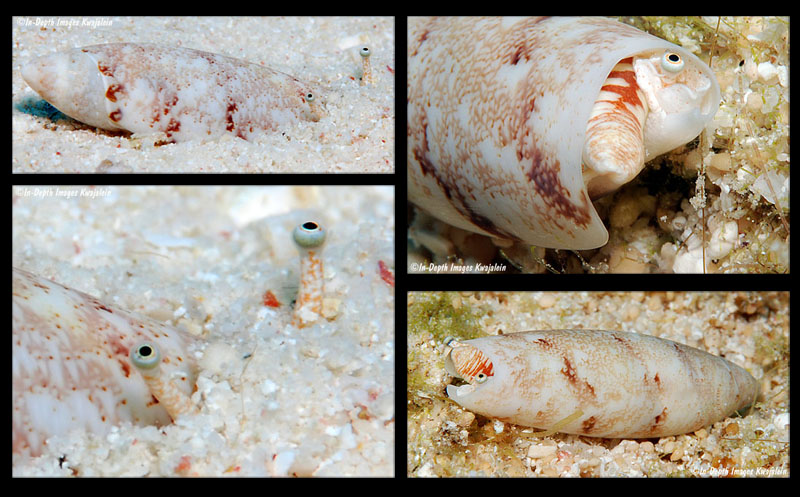|
edit SideBar
|
Scott Johnson
Jeanette and Scott Johnson from Kwajalein on Harpago chiragra:
- "Harpago chiragra is the second largest of the Strombidae in the Marshalls, second only to Lambis truncata. It is common on both lagoon and seaward reefs, including the large flat-topped lagoon pinnacles. They are typically on sand or rubble, or sometimes on hard substrate. Adults are nearly always seen paired, with a large female accompanied by one, or rarely, a couple of smaller males. Like the large Lambis truncata, this species is protected (at least where divers from Kwajalein are concerned), although the initial protection recommendations from Fish & Wildlife and the Kwajalein Army regulations on the issue both misidentified it as Lambis scorpius, a very different and much smaller species. More comments about this under L. truncata. The individual in the first two photos below had unusually long and recurved "fingers."
bottom right: The eyeballs peek out over the operculum in this aperture view.
- top row: "Here the green proboscis bearing the mouth can be seen between the two eye stalks in this juvenile specimen."
- bottom left: "As the fingers develop, they remain hollow for a while until they eventually fill in."
- bottom right: "The specimen was putting down an egg mass, seen as the whitish sandy area just to the right of the shell. Like some of the other Strombidae species, H. chiragra mixes up its eggs in a sand and mucus slurry that holds together while the eggs develop. What surprised me is that this female is still rather young, with fingers that have not completely filled out."
"Here's another young one getting ready to flip"
Harpago chiragra; Kwajalein, 1/2013; Jeanette & Scott Johnson
Jeanette & Scott Johnson on Lambis crocata from Kwajalein
- "Lambis crocata is the rarest of the finger shells found in the Marshalls. We have seen most specimens on lagoon pinnacles, sometimes with Lambis scorpius, with which they occasionally hybridize. They seem least rare on a few northern Kwajalein Atoll large lagoon pinnacles, although very rarely a specimen can be found on the seaward slope. The aperture is bright orange. The exterior of the shell is orange as well, but that is often completely hidden beneath calcareous deposits in older specimens."
"The brown proboscis and mouth is between the two eye stalks."
"We had never seen Lambis crocata in the Halimeda patches we frequent along the east reef of Kwajalein Atoll, but recently over a span of a couple of weeks, we saw three very small but fully adult individuals sitting out on top of the algae. One of these is shown in the four photos above. We continue to be amazed how things change over time as species come and go."
Jeanette and Scott Johnson on Lambis lambis from Kwajalein Atoll:
- "Lambis lambis (along with L. truncata) is by far the most abundant of the finger shells found in the Marshalls. This species is found most often along lagoon reefs all the way up into the intertidal. Most older specimens have heavily encrusted shells and broken or worn-away fingers. The specimen in the first two photos below is almost certainly a female; they tend to have longer upward curved fingers, while those of males tend to be short and straight. This species is widely distributed from the western Indian Ocean through the Marshalls."
- top left: "An eye peeks out from under a notch near the anterior end of the shell."
- top right / bottom: "This species deposits orange eggs in long tangled spaghetti-like masses under rocks and in algae."
Jeanette and Scott Johnson on Lambis scorpius from Kwajalein Atoll:
- "Lambis scorpius is common in the Marshalls, but not often seen because it blends in so well in its typical rubbly surroundings. They are most common on lagoon pinnacles and on the seaward reef, but can also occasionally be found on lagoon interisland reefs as well. It does not range up into the intertidal, however. We've seen hybrids between this and the much rarer Lambis crocata. The specific name is derived from the anterior finger (on the right side of the shell below), whose curve reminds one of a scorpion's tail."
"The brilliantly-colored aperture starkly contrasts with the usually drab and encrusted dorsum. However, young specimens that lack the dorsal growth can be quite colorful."
- top row: "The dorsal coloration can be seen beneath the developing encrustations on these two young shells."
- bottom: "Fingers are made last as the animal grows, starting out hollow and gradually filling in."
Jeanette and Scott Johnson on Lambis truncata from Kwajalein:
- "Lambis truncata is distributed across much of the Indo-West Pacific, but is often split into two separate subspecies. Lambis truncata truncata is found in the Indian Ocean, while Lambis truncata sebae (Kiener, 1843) is the form found in the Pacific. It is the largest of the finger shells and is very common in the Marshalls in a variety of habitats. They can be seen in good numbers in lagoon sand and Halimeda algae flats; on rubble and the hard reef flat as shallow a meter of less; on lagoon pinnacles, particularly the large and flat-topped ones; and on both eastern and western seaward slopes, both on the top of the slope and down the sides. Fish & Wildlife, who came to Kwajalein at the request of the US Army to survey the marine environment surrounding islands it leases, chose to recommend this and Harpago chiragra be made protected species. (Although they originally misidentified H. chiragra as L. scorpius.) Curiously, the reason for recommending the protected status was basically that...they were there. That is, specimens were present off the leased islands where they did their sampling, so therefore the shells might get collected. Hmm, you could do a lot with that kind of reasoning. (Tuna are in the waters around Kwajalein and they might get caught, so perhaps they need to be protected as well.) In any case, the recommendations were accepted and these are now protected from sport scuba divers and snorkelers who work as contractors on the Army base. However, the species can hardly be said to be threatened, especially from sport divers, who I'm sure only very rarely ever picked up a specimen as a souvenir. If there is a threat to this species, and I don't really think there is, it is because the local islanders collect them for food. I have seen piles of broken shells collected by Marshallese fishermen in one day that contained more shells than, I'm sure, all the specimens collected by sport divers on Kwaj over a span of years. Yet the local Army regs do not and cannot regulate Marshallese fishermen. I'm not saying it is a good idea to collect them, or that it is a bad idea to discourage collecting them; however, this particular regulation does nothing to add to their protection. Expending effort to protect species that do not really need it dilutes the importance of protecting species that really can use it, such as the giant clam Tridacna gigas. Those are too scarce and their numbers have declined. Unfortunately, the greatest threat to Tridacna is also fishermen harvesting the animals to eat, and there is not much that can be done about that."
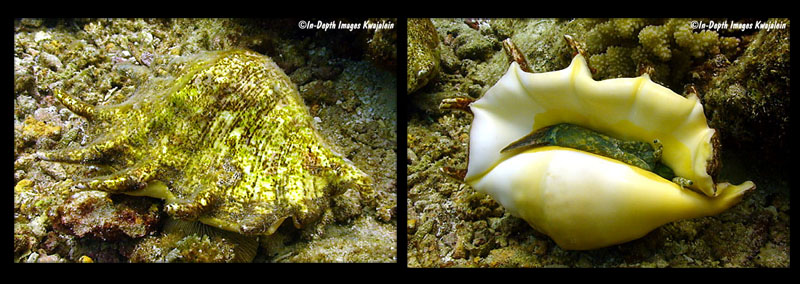 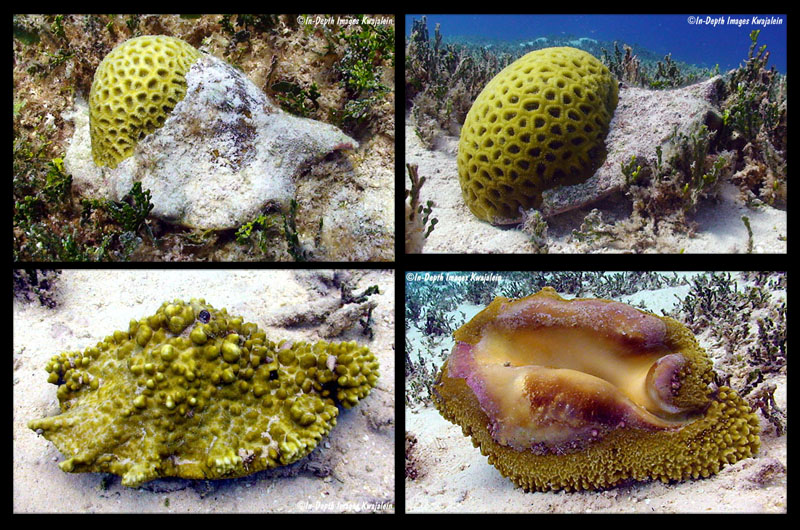 - top left: "Most specimens are old with worn-off fingers and heavily encrusted with dorsal calcium deposits, up to and including colonies of various corals, such as the faviid coral growing on the shell."
- top: "Here's a real head scratcher. The specimen on the right was observed in the same area as the one on the left. The photo above was taken on 24 September 2009, while the one on the right was shot on 1 June 2010. Could the coral carried by that overburdened mollusk possibly have grown that much in a mere nine months? Or did the one on the left simply move out of the area and the one the left move in? I wish I'd marked it somehow! It seems the large size of Lambis truncata shells makes for a good settling site for coral larvae, particularly in the soft sandy or algae habitats these shells frequent."
- bottom: "This one's shell is completely encrusted with Millepora fire coral, with the fire coral even encroaching into the living space of the molluscan occupant. I felt sorry for this guy. It must have been painful to extend his eye stalks out through the anterior notch with all that stinging fire coral around. I wished I'd been carrying a chipping hammer to try to chip some of the coral away."
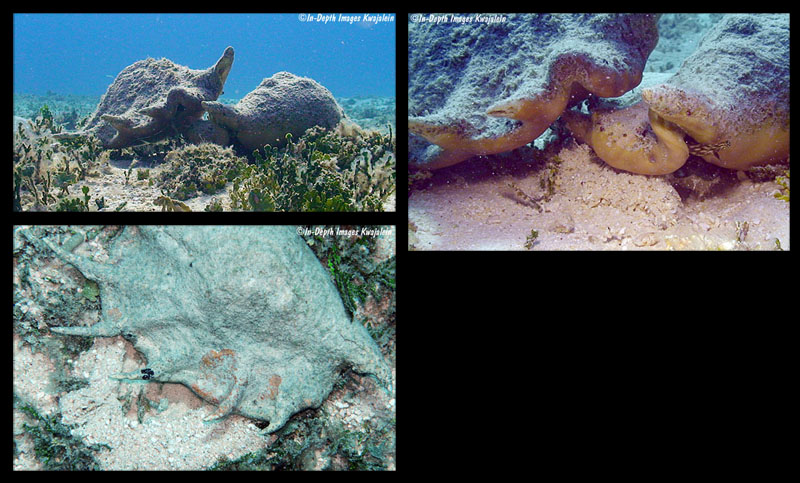 - top: "This pair in a Halimeda patch are putting down an egg mass, seen as a mass of mucus packed sand just below the shell in the second photo on the right."
- bottom: "Here's another egg mass just below the shell in the photo."
- top left: "Despite their large size and thick shells, they do fall prey to some creatures. This shell was on a midlagoon pinnacle, far from anyplace where people could have likely broken the shell in order to eat the animal."
- top right: "The stalked eyes peek out of the shell's aperture. Looks a bit cross-eyed."
- bottom: "Here's a group on a Kwajalein lagoon pinnacle. Some of these large flat-topped pinnacles are the best places to see a lot of specimens in a small area."
"Lambis truncata often provides a surface for settling coral larvae. I wonder how large one of these corals has to get before it prevents the poor snail from moving. I also wonder how many coralheads started off with a nucleus consisting of one of these shells."
- middle right: "More fire coral Millepora with a little chunk of Porites."
Jeanette and Scott Johnson on Canarium erythrinum from Kwajalein Atoll:
- "Canarium erythrinum is sporadically common in the Marshalls, usually being limited to specific habitats. Nearly all specimens are found hiding among algae stalks in lagoon Halimeda beds. We know about three algae beds where they are common, but they are almost absent elsewhere, and are never found on the seaward reef. Several broken shells and dead specimens were found cemented into carrier shells of the genus Xenophora found in a Halimeda bed on the lagoon bottom of Enewetak Atoll at a depth of about 60m in 1982, so perhaps they are also common in some deeper water lagoon bottom Halimeda patches. The shell comes in a variety of colors and ranges up to about 35mm in length. The photos below show just a few of the color forms."
Jeanette & Scott Johnson about Canarium haemastoma on Kwajalein Atoll:
- "Canarium haemastoma are mostly relatively rare in the Marshalls, but when found usually occur in groups. They can be found buried in the top layer of coarse sand or fine rubble in seaward reef sand patches from about 8 to 25m depth, or they can be found in lagoon Halimeda beds or even crawling on the surface of the sand in 6 to 13m. Occasional specimens have been observed in sand patches on large flat-topped lagoon pinnacles. While the Latin name technically means blood mouth, there is another, better known stromb commonly called the blood-mouth conch, so we will leave this one without a common name. Besides, the animal must have been named from a faded specimen since the aperture coloration is more purplish black than red in living animals, and only fades to red or orange long after the animal has died. So the name is kind of a misnomer. This is a smaller species, ranging up to about 30mm in length."
Jeanette & Scott Johnson about Canarium maculatum on Kwajalein Atoll:
- "Canarium maculatum are very common in very shallow and intertidal reef habitats in the Marshalls. They are often overlooked due to their small size of around 15mm."
Jeanette & Scott Johnson on Canarium microurceus from Kwajalein Atoll:
- "Canarium microurceus is a rather uncommon species found primarily at depths of 10 to 25m on the seaward reef slope, although occasional specimens are seen on lagoon pinnacles or the interisland lagoon reef."
Jeanette & Scott Johnson about Canarium mutabile from Kwajalein Atoll:
- "Canarium mutabile are abundant on very shallow lagoon and seaward reefs in the Marshalls, more common in the lagoons. They range from the intertidal down to at least 10m and can be found on sand, rubble, or hard reef substrate, or even in Halimeda plants. Most shells are mostly whitish in color, but a few, such as the ones figured below, can be quite pigmented."
Jeanette & Scott Johnson about Canarium wilsonorum from Kwajalein Atoll:
- "Canarium wilsonorum is a species with a couple of distinct growth forms in the Marshall Islands that live in different habitats. Specimens from the rubble and under rocks on seaward reef in 10 to 25m of water are small, short, and rather squat. The larger population that lives shallow lagoon Halimeda beds have shells that tend to be much larger, narrow, and elongate. Although the larger seaward reef specimens may match the smaller lagoon specimens in length, those from the lagoon seem distinctly narrower and more elongate. It almost seems as though we are looking at two different species. Both forms are highly variable in color."
"The specimen came from the seaward reef. The rest are from lagoon Halimeda patches."
- bottom left: "A hermit crab has taken over the yellow shell below."
- br: "A tiny shell in some stringy algae."
Jeanette & Scott Johnson about Conomurex luhuanus from Kwajalein Atoll:
- "Conomurex luhuanus are abundant within Marshall Islands lagoons, but are rarely found on the seaward reefs. Specimens can be found in large numbers on many shallow sand and rubble lagoon interisland reefs as well as on pinnacles at depths from about 1 to at least 16m. Sizes range up to about 60mm. Most specimens have an orange-red aperture, hence the common name (Blood mouth conch). A few, however have apertures either yellow or pure white.
- top: "Both orange and white aperture specimens"
- bottom: "Closer shot of a relatively clean-shelled individual. The underside shows the orange red aperture."
- top: "Like other Strombidae, it has a long proboscis for feeding on algae."
- bottom: "A pair of algae and sand encrusted individuals with an egg mass, mixed in with that clump of sand in front of the two shells."
Jeanette & Scott Johnson about Dolomena variabilis from Kwajalein:
- "Dolomena variabilis are relatively rare in the Marshalls, usually found on fine sandy lagoon slopes, primarily at night. We have found specimens from about 12 to 40m depth, and they range up to about 42mm in length."
- bottom left: "The proboscis and grazing mouth are visible below the eye on the left in the photo."
Jeanette & Scott Johnson about Euprotomus aurisdianae from Kwajalein Atoll:
- "Euprotomus aurisdianae is known in the Marshalls from a single empty but clearly recognizable shell found at a depth of about 40m on the Kwajalein Atoll seaward reef in 1967. The Marshalls is so far out of this species' normal range (East Africa to the Philippines and Solomons) that we would have been tempted to disbelieve it except that it was one of us who found the shell. While we have seen the shells of species obviously not found here being dragged around the island by hermit crab inhabitants, we know that some or all of these are shells stolen by hermits from people who actually brought them here. Once we found a Caribbean volute inhabited by a terrestrial hermit on Kwajalein. We do know people who have purchased and imported quantities of "craft" shells from dealers in Florida and Oregon. But the E. aurisdianae was in a place where it would have been highly unlikely to have been brought in. First, it was found in the early years of sport diving here, long before people started to bring shells to Kwajalein. Second, it was deep on the steep outer slope a good 8 kilometers up the reef from Kwajalein, the closest inhabited island, and the condition of the shell was far too fresh to have possible been carried that far by a hermit crab. And it would have been a most unlikely to plant a gag shell as a joke because it would have been highly unlikely to ever have been found in that location. We can only assume that somehow, a stray larva made it to Kwajalein and developed here. We obviously do not have a photograph of a living Marshall Islands specimen."
Jeanette & Scott Johnson about Gibberulus gibbosus from Kwajalein Atoll:
- "Gibberulus gibbosus is abundant in many lagoon sand flats in the Marshalls. In some areas in seems to be the most common mollusk present. They are seen only rarely on the seaward reef. They range from about 1 to at least 20m depth, and probably often extend deeper as well. The largest we know of was about 49mm long. Sometimes the shell is pure white, but it often is variably marked with brown, and may have a purple or white aperture. Occasionally we see piles of shells that have been recently cleaned out by some predator without damaging the shell. We suspect some nocturnally active octopus is pulling the animals out of the shells and devouring them in large numbers."
"The interior of the aperture can be purple or white."
"They can frequently be seen gathering on sand flats to breed, leaving their eggs in mixtures of sand and mucus on the top of the sand."
- top: "We found this large group marching (well, hopping) down a sandy lagoon slope all in the same direction on 5 October 2009. You can see the crowded front line toward the upper part of the first photo below, with their tracks in the sand trailing toward the lower left. The front line extended a good 10 to 12m and there must have been thousands of the mollusks, all apparently of the same mind(?) about where to go."
- bottom: "Another marching horde observed on 22 July 2012."
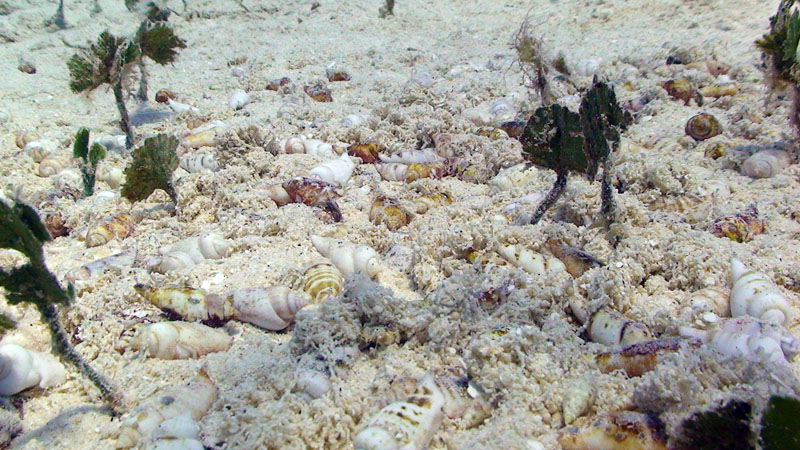 - Photo of a cluster of G. gibbosus mixed in with their spawn, which is covering the sand between the shells. (1/2013)
- The real distinct herder is Gibberulus gibbosus, where many hundreds come together and move around as a group. Sometimes these groups can be seen to have all spawned at once, leaving piles of sand-infused egg masses all over the surface of the sand. I've watched these groups for a while, and there seem to be no specific pairing up. Particularly when the herd is moving, it seems a chaotic mass where the entire group is hopping along with no regard for pairing up. Even when a group like this is in or moving through an area, there seem to be plenty of individual specimens around that are not part of the group and seem to have no interest in joining as the group passes."
Jeanette & Scott Johnson about Lentigo lentiginosus from Kwajalein Atoll:
- "Lentigo lentiginosus are moderately uncommon in the Marshalls. They can be seen in some areas quite regularly, but unlike many other species, never in large numbers. They live in sandy and rubbly areas on lagoon reefs, pinnacles, and shallow portions of the seaward reef, where they frequently, but not always, bury in the sand during the day. They are often found in pairs at depths of about 3 to 13m, and adult shells range in size from about 65 to 90mm.
"The elongate tube irregularly striped with green and black on the right side is the proboscis, with its mouth at the very tip. Like all other strombs, this species grazes on algae."
Jeannette & Scott Johnson about Lentigo pipus from Kwajalein Atoll:
- "Lentigo pipus are extremely rare in the Marshalls, known from this single pair of specimens from a shallow lagoon reef in the northern half of Kwajalein Atoll found on 13 August 2006. They were at a depth of about 5m on rubbly sand, and both measured close to 54mm in length. This species is known from sporadic locations throughout much of the Indo-Pacific, but I don't believe it has previously been reported from Micronesia."
- "The shell at the bottom left appears to be older, with a thicker ventral nacre, than the one at the top right."
- "Like other strombs, the proboscis of this species can stretch way out looking for its algae food." (middle right)
Jeanette & Scott Johnson about Sinustrombus sinuatus on Kwajalein Atoll:
- "Sinustrombus sinuatus are uncommon to rare in the Marshalls. Most Kwajalein Atoll specimens have been found on sand and rubble at the base of lagoon pinnacles at depths of about 30 to 40m. Occasional specimens can be found shallower on pinnacles, or in Halimeda patches along the lagoon interisland reefs. Several have been found on the decks of sunken World War II ships at about 35m. Specimens on the seaward reef are very rare. Shells we have measured ranged from about 88 to 107mm."
"Although usually rather rare at Kwajalein, on 5 September 2010 a number of specimens were observed on the rubbly slope of a large Kwajalein Atoll lagoon pinnacle, including several pairs and the one group of four illustrated below. They may have had a particularly good settling last year, or may have just come together for mating."
Jeanette & Scott Johnson about Sinustrombus taurus from Kwajalein Atoll:
- "Sinustrombus taurus are known primarily from the Marshall and the Marianas Islands. In the Marshalls, they have a very patchy distribution. We saw none in three years of searching at Enewetak Atoll. On a short research trip to Rongelap in 1982, we looked where they had been reported more than 22 years before (Indo-Pacific Mollusca), and there was still a healthy population. At Kwajalein, there are a few large lagoon pinnacles in the northern half of the atoll where there are a fair number, usually distributed in pairs or sometimes groups of three on sand and rubble at depths of about 8-10m. Also, at some spots along the northern atoll interisland reefs they form rarely-found taurus "herds" where 50 or more specimens distributed usually in pairs might be counted in an area of sand, rubble, and Halimeda a hundred meters or so in diameter. Such a herd might last a year or two in an area then disappear. Another place where specimens are occasionally seen is on sand and rubble at the bases of some large midlagoon pinnacles at depths of 30 to 40m. Curiously, at Kwajalein they are nearly absent from the southern half of the lagoon. A couple of specimens have been found on the seaward reef, but they are very rare there. Shells range up to about 120mm in length. Most shells are heavily encrusted and often bear shell-damaging cap shells or vermetid "worm" (mollusk) tubes."
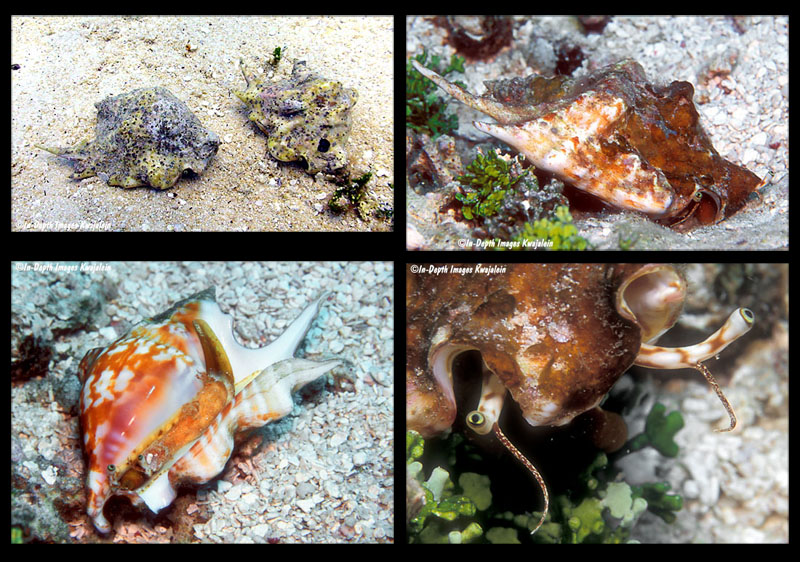 - top left: "A pair of moderately encrusted specimens on a typical sand and algae substrate."
- "The further three photos show a younger shell with brighter than usual coloration."
- top left: "This specimen is still thickening up its outer lip and filling in its spine."
- top right: "A group of three is well camouflaged on a sand, rubble, and algae substrate."
- bottom left: "A juvenile."
- bottom tight: "Egg masses, like that just below the specimen, are mixed up with mucus and sand and often buried under the top layer of sand. The longer spine on this female is broken off, a common flaw in the shell."
Jeannette & Scott Johnson about Terestrombus fragilis from Kwajalein Atoll:
- "Terestrombus fragilis is uncommonly seen alive, but it must at times be quite common in some areas. When parts of the lagoon bottom at Kwajalein were dredged some years ago to extend the island, many T. fragilis shells were dredged along with the sand and rubble. Empty shells are also often seen on deep lagoon shipwrecks, so they may be more common in the deeper lagoon. Nowadays, we see them in lagoon Halimeda beds and also in piles of rubble along the lagoon reef from about 3m on down. They seem to not occur on the seaward reef at all. Shells range up to about 49mm in length."
Jeanette & Scott Johnson about Tridentarius dentatus from Kwajalein Atoll:
- "Tridentarius dentatus is common in the Marshalls, living in both lagoon and seaward reef habitats, usually in sandy or rubbly areas. On the seaward reef, they are common sand patches, often buried in flake sand and fine rubble, at depths of 5 to about 25m, and they occasionally extend deeper. There are often larger specimens in some shallow lagoon sand patches, particularly in beds of Halimeda algae. The name is derived from the three pointed projections from the outer lip near the anterior end. Like other members of the family, the eyes are at the ends of long stalks. Shells range from about 22 to 52mm in length."
Jeanette & Scott Johnson about Terebellum terebellum from Kwajalein Atoll:
- "Terebellum terebellum used to be considered one of the Strombidae, but now is often put in its own family, the Seraphsidae. They are reasonably common buried in sand in lagoon and seaward reef areas. It is a very active animal capable or rapidly burying in the sand, hopping away, or even swimming several meters through the water. It appears to spin its foot kind of like a propeller for swimming. A rather thin and fragile shell, it would probably be easy prey if it could not move so quickly. Some have called it the fastest snail. Marshall Islands specimens have been found between about 5 and 20m depth, and range in shell length up to about 34mm. This species is known to be distributed widely in the Indo-Pacific, from east Africa and the Red Sea to the Marshalls and Samoa."
"Note the long stalked eyes poking up through the sand."
Jeanette & Scott Johnson about Strombidae from Kwajalein Atoll:
- "We have seen strombid herds in only a few species,and sometimes the term "herd" might not be appropriate. Sinustrombus taurus, for example, is often found in groups spread over up to about 100m of sandy or rubbly reef flat, but the grouping usually consists of discrete pairs or trios separated by some distance from similar pairs or trios."
- "I have noticed trios sometimes instead of pairs in such species as S. taurus, Lambis lambis, L. truncata and Harpago chiragra (and maybe a few others). I cannot say I know how to distinguish sexes in some, but in others where I can make a guess--such as L. lambis where the female has the long upward pointing fingers, and H. chiragra, where the males are usually significantly smaller, it is nearly always a single female with two males."
All Photos of Kwajalein Atoll-specimens courtesy Scott & Jeanette Johnson, Kwajalein Atoll
|

